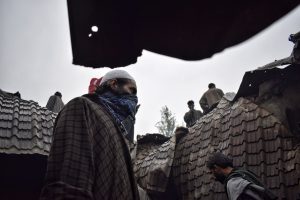The Himalayan region of Kashmir, one of the most militarized regions in the world, is claimed by both India and Pakistan, who each administer parts of it. On August 5, the Indian government withdrew provisions granting autonomy under Article 370 of the national Constitution and divided the Muslim-majority state of Jammu and Kashmir into two union territories to be controlled by the federal government.
In Indian-administrated Kashmir, this conflict is taking a heavy toll on Kashmiri lives and the ever-increasing number of fatalities consists largely of Kashmiri youth. According to reports, more than 1,500 people were killed in the last three years, including 700 rebels, 430 civilians, and 388 Indian security personnel.
More and more young boys are joining the armed resistance against Indian rule, with some reports saying at least 300 youth have turned into rebels since the killing of Burhan Wani, a charismatic rebel commander, in July 2016. Many believe it was his killing that triggered a wave of protests and prompted many boys to pick up gun.
The encounters have taken a toll on the local populace, financially, mentally, and physically, as civilian deaths over the years near encounter sites has increased manifold.
Last year alone was one of the deadliest years in Kashmir’s recent history. According to data from the Annual Human Rights Review produced by JKCCS, a Kashmir-based monitoring group, violence in 2018 claimed some 586 lives, which included 160 civilians, 267 rebels, and 159 members of the Indian armed forces. In addition, as many as 120 civilian houses were either completely destroyed or partially damaged when set ablaze by Indian forces during the counterinsurgency operations.
These counterinsurgency operations are shredding the very fabric of Kashmiri lives and turning out to be an absolute horror for the local populace.
Such operations are frequent. Almost once in a week an encounter ensues between a well-equipped, well-entrenched counterinsurgency force (such as the Special Operations Group, Rashtriya Rifles, and the Central Reserve Police Force) and the rebels.
These encounters, which last from hours to days, generally end with the security forces using incendiary explosives to blow up the building in which the rebels are holed up. Some of these lethal explosives remain unexploded near the encounter site; locals allege they are deliberately left undefused even after the encounter is called off successfully.
Encounters between rebels and Indian government forces are daily news and the local population does not shy away from expressing its support for the armed struggle. People here say that a new wave of local rebellion is gathering strength in Kashmir.
Instead of creating fear, encounters enact the idea of martyrdom in the Valley. They are usually followed by the vast public funerals that have become a familiar sight by now. At the same time, the demonstrations have changed the dynamic between civilians and government forces. Some even say the burning down of houses is a statement to the public that they should refrain from sheltering the local rebels and stop supporting them. It is a violent message being delivered to the common public of Kashmir.
Zafar Dar is a freelance photojournalist based in Kashmir.












































